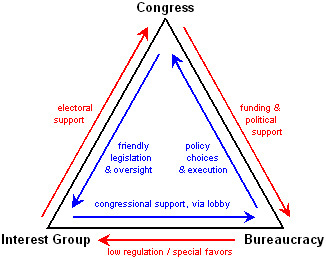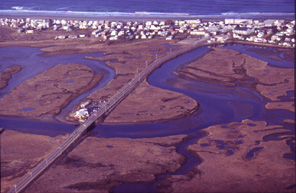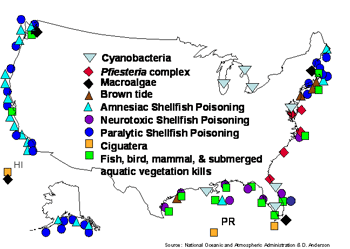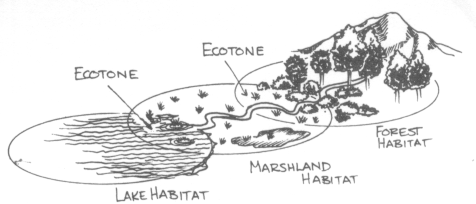| Marshes of the Ocean Shore |  |
Book Notes |
Previous chapter |
This chapter |
Next chapter |
 |
||
Martin Johnson Heade, Winding River marshes, 1863 |
||
Marshes of the Ocean Shore Book Notes Previous chapter
This chapter
Next chapter
Martin Johnson Heade, Winding River marshes, 1863
 Chapter 8: Politics and the Preservation of Estuaries
Chapter 8: Politics and the Preservation of Estuaries
Estuary's hidden values | tidal marsh as sources | protection policies | marsh preservation | Conclusion | coastal conservation | Wildlife
Review | Premise | Significant Ideas | Key Players | Map | Failure | Related pages | Summary
"The pejorative implications of the words morass, slough, muck and miasma still associated with wetlands need no comment, These terms are common synonyms for obstruction, nuisance and disease. Yet as part of the national 'battle to preserve the common estate,' coastal marshes and tidal flats became the focus of a major drive for the protection of natural resources during the late 1950s."
 The key to understanding how laws are changed is this "triangle" of interests among competing constituencies, Federal bureaus, & Congress.
The key to understanding how laws are changed is this "triangle" of interests among competing constituencies, Federal bureaus, & Congress.
The National Estuary Protection Act, 1968
Cultural significance of coastal preservation
Meaning of conservation and ecological
protection
Key Players
Review of Chapter Eight's main points:
![]()
National Battle to preserve the common
estate

"The first principle of conservation is development," G. Pinchot (Chief forester of USA.)denying the individual the right to harm the public or damage a public good
preservation of wildlife habitat and scenic beauty
Density of population and development
movement from an older biocentric concern to an ecologically --ecocentric-- centered vision of protecting wetlands, marine mammals, beaches, mangroves, marshes and water quality.
![]()
![]()
Estuary's hidden values | tidal marsh as sources | protection policies | marsh preservation | Conclusion | coastal conservation | Wildlife
Review | Premise | Significant Ideas | Key Players | Map | Failure | Related pages | Summary
The exposed area between the tides is called called tidelands extending from low water (lowest annual average tide level) to the highest (annual average) tide; tidelands are public property in most states and held in trust by the states for purposes of access for purposes of navigation, fishing and hunting as a matter of civil right.
The ecocentric approach to protection is symbolized by predator and prey relations within chemical and physical conditions of existence. For example, in places the systemic relations among keystone species, habitat protection and the entire biotic community has emerged as the foundation for or the focus of preservation efforts.
There are organisms that live in the oceans and in estuaries that thrive no where else on earth; making these areas productive for fisheries, birds and wildlife. Carson, Leopold, Odum, Hedgpeth, and Gilliam among many writers made these ideas understood to the wider public, to Congress, Congressional staff, and to advocates such as Justice William O. Douglas and Stewart Udall, Secretary of the Interior.
Review | Premise | Significant Ideas | Key Players | Map | Failure | Related pages | Summary
LBJ called, the "new conservation," in 2 - 8 - 1965, speech
Many estuaries were the places where the nation was growing the fastest.
Average residential density of the US versus coastal areas where population density increased sharply
Anne Simon, 53% of the nation lived near the lakes or seashores in the 1970s.
Southern California and Chesapeake Bay density comparisons from 3,980 to 940 persons/ square mile are example of pressures from urban storm-drain runoff from rains and snow, construction debris adding to sedimentation and cloudy (turbidity is the measure of clarity of a water body) water that stifles or impedes photosynthesis thus eventually depriving the area of sufficient oxygen in the water to sustain fish.
One consequence of population density is (but does not have to be) water quality and it declined precipitously due to dumb design, failure to regulate, and special interests who promoted reckless development.
Estuary's hidden values | tidal marsh as sources | protection policies | marsh preservation | Conclusion | coastal conservation | Wildlife
Review | Premise | Significant Ideas | Key Players | Map | Failure | Related pages | Summary
Water
protection of water quality was supposed to be assured by the passage of two Clean Water Acts, but Congress failed to provide equal roles for the Fish and Wildlife Service and the Interior Department with the more powerful Army Corps of Engineers whose interest was more to promote ports and marinas through approving dredge and fill permits than it was to protect waterfowl, fisheries, or tidal marshlands.
Electricity use soared 500 % over the increase in population and thus the demand for water increased accordingly since there is no electricity without ample amounts of water.
Electricity is second only to agricultural withdrawals for irrigation of crops so far as the demand for water is concerned.
Consider the per capita demands for water and resources by industrial consumption
1965, water use by Americans was 1,900 gallons / day / person
Agricultural use of water; of that the wheat crop required 300 gallons per day
If food is considered part of the nation's daily water use jumps to 2,500 gallons / day / person
Synthetic chemicals (not including petroleum and pesticide / herbicide derivatives) required 100,000 - 200,000 gallons per ton of rayon (a fabric).
Case gallons water / ton Product 1 100,000 Rayon 2 50,000 Steel 3 39,000 Paper Water pollution problem conditions in coastal watersheds.

Water is essential for all life, yet clean drinking water is necessary for development and for hyper-industrial civilization in ways that are not fully, nor well-appreciated.
pp. 161-162.
Problems in addition to the quantity of water that bedeviled (damaged) estuaries, rivers and lakes:
- recreational demand
- fixed tax base called ad valorem tax system
- increase in uses of cement
- electricity and power plant siting near water
- water quality decline
The lessons of river and estuarine pollution in the nation and around the world are related to the facts of the quantity, quality, timing and distribution of water in a coherently systematic delivery system nourishing the needs of keystone species and productive ecological units. Those concepts are the keys to economically enduring resources that conservation is designed to manage, protect and deliver on a sustained-yield basis.
Estuary's hidden values | tidal marsh as sources | protection policies | marsh preservation | Conclusion | coastal conservation | Wildlife
Branches of government support
Review | Premise | Significant Ideas | Key Players | Map | Failure | Related pages | Summary
Stewart Udall's The Quiet Crisis, Secretary of the Interior, from Arizona 1961-68.Three waves of conservation reform, were distinguished by their leadership:
- Theodore Roosevelt, Gifford Pinchot & W. J. McGee: "conservation" as to stop wasting scarce resources and apply wise use for the benefit of all.
- Franklin Roosevelt, Harold Ickes: Soil, water, flood control, fishery & wildlife protection based on comprehensive planning among agencies.
- John Kennedy and Lyndon Johnson the ecological perspective used to balance the clash between preservation (19th Century) and conservation (20th Century), Stewart Udall, Edward Kennedy, Rene Dubos.
Congressional support in Senate and House
Supreme Court decisions
Justice William O. Douglas on planning and zoning, support for
Douglas call for "A Wilderness Bill of Rights"
Upper Yosemite Valley from the air in winter looking west toward the east with Half Dome in the bottom center of the photograph. When Frederick Law Olmsted Sr. first saw this landscape he proposed that it be preserved for future generations because of the valley's geological and forested (the oldest and largest redwood tree groves) features.
Estuary's hidden values | tidal marsh as sources | protection policies | marsh preservation | Conclusion | coastal conservation | Wildlife
Review | Premise | Significant Ideas | Key Players | Map | Failure | Related pages | Summary
National background
California | New York | Congress | Federal Bureaus
The vague notion of an estuarine preservation ideal was being translated into policies and needed laws to protect and balance competing interests in the coastal zones all across the nation's more densely settled coastal cities.Regional needs from West, East and Gulf coasts were similar: water pollution abatement, transportation development, dredge and fill of wetlands, levee and canal maintenance, port and marina construction, fuel storage and energy production all required a coordinated as opposed to a laissez faire approach with the largest land holders determining the fate of underground water, streams and rivers in congested coastal areas.
California and especially along the Bay Area of San Francisco transportation planning triggered regional concerns when local preservationists realized the Army Corps of Engineers had plans to fill in 75% to 80% of the remaining bay bottom and adjacent wetlands.
ABAG, Association of Bay Area Governments
Army Corps of Engineers and filling in of San Francisco Bay
The map (above) shows the extensive areas remaining today along the bay where tidelands were retained as marshes, mud flats, or oyster bars, for fisheries and birding areas. These extensive bay bottom and marsh lands were once slated to become marinas, developed lots and commercial real estate, as had been the custom in San Francisco since 1848.
Bodega Bay and the nuclear plant proposal on the San Andreas fault zone
Save San Francisco Bay Association
Corps violated the Fish and Wildlife Coordination Act of 1934
Extent of salt marsh habitat in the bay is in deep blue.
State legislators were pressured to create a regional planning body: The Bay Conservation and Development Commission, (BCDC) for all of San Francisco bay's surrounding counties in June 1965.
The counties were included in this agreement as follows:
- San Francisco, oldest settlement, 1800s.
- San Mateo (Palo Alto), Stanford
- Santa Clara (San Jose), silicon valley
- Alameda (Oakland), largest container port
- Contra Costa (Concord - exurbs),
- Solano, vast marshes for bird migration & elk relocation
- Napa, river and riparian marshlands (Naval shipyard)
- Sonoma, (exurbs)
- Marin (suburbs) Muir Woods.
In 1970, Proposition 20, called for amending the State Constitution to allow for Coastal Protection of all the areas along the California shoreline to balance commercial, scenic and ecological values in an effort to afford access to the coast by citizens and continuing productive use of marine resources by commercial, sport and subsistence users.
Estuary's hidden values | tidal marsh as sources | protection policies | marsh preservation | Conclusion | coastal conservation | Wildlife
Review | Premise | Significant Ideas | Key Players | Map | Failure | Related pages | Summary
Boston, Cape Cod, and Chesapeake Bay had parallel development related conflicts to Great South Bay in southern Long Island.
Cape Cod, the Nauset marsh and dunes on Massachusetts Bay, looking east.1952 Conservation Department of the State of NYCarson's Silent SpringCrisis of Long Island wetlands and coastal dredge and fill operations
Oyster Bay, Town of Hempstead. 29% of Long Island wetlands were lost in 10 years (1954-64)
New York City flight to suburbs, Nassau county tripled in population in 30 years
Affects of toxic DDT in Long Island Marshes, George Woodwell showed that ducks, osprey and eagle shells were weakened by the pesticide
Storm King Electrical Facility & Indian Point nuclear plant both were on the Hudson River and the reactor was near the river's spawning grounds of striped bass (center photograph).
Fish, shellfish and other animals require the estuarine marshes and tidal marsh productivity to survive.
Estuary's hidden values | tidal marsh as sources | protection policies | marsh preservation | Conclusion | coastal conservation | Wildlife
Legislative history
Review | Premise | Significant Ideas | Key Players | Map | Failure | Related pages | Summary
the fight against filling of Great South Bay, 1963-1965.
The Great South Bay is to the lower right of this satellite image.
1966 a bill was introduced in Congress to expand comprehensive planning in coastal areas
Massachusetts interests entered the array of supporters as the 1966 bill was defeated
In 1965, Governor John Volpe of Mass. expanded DNR permitting to protect 45,000 acres of coastal marshes in that state.
Takings issue explained. the use of private land for public purposes and reasonable compensation based on the the fifth amendment.
Northern California citizen pressure
Fish and Wildlife Coordination Act of 1934
amended in 1946
Congressional action for water quality
1948 and 1956 precedents in assisting local governments in making water purity a national matter
1955 USDA had declared the "year of wetlands" raised awareness about need to buy fish and bird habitat, pursuant to federal treaties and laws (Lacey Act).
Water Quality Act of 1965, water pollution was accepted as a federal problem to be dealt with nationally
By 1960 NY State provided grants to Long Island to purchase wetlands.
Federal support for regional and comprehensive planning in 1962
NOAA, 1970 and the Intergovernmental Coordination Act of 1968
Land and Water Conservation Fund, 1964, was a novel means of funding recreation purchases
Federal desire to balance development and coordinate the government bureaucracy:
An example of programmatic coordination today.
Congressional intent appeared to be moving in the direction of coastal conservation
The necessity for protecting species and the public trust doctrine with respect to water quality, quantity, timing and distribution throughout a maritime wetland area, adjacent shores and river channels.
1965 Rep. Tenzer introduced Long Island Wetland Protection bill
1966 version of the bill favored by the Administration and Chairman Dingell would have given the Secretary of the Interior control over Dredge and Fill Permits, instead of Army Corps of Engineers.
Dingell-Kennedy Bill was defeated in the House by three votes on 10-3-1966.
Alabama, Mississippi, & Virginia Congressional delegations were opposed.
Absenteeism was a factor as was Republican opposition which spearheaded the defeat.
1967 the bill was re-introduced in the House.
1968 A Senate version of the bill was accepted by the House.
Opposition was from The Army Corps of Engineers over the dual permitting system envisioned by the legislation
Great Lakes were included to build support for the bill.
Summer 1967 Stewart Udall and the Army Corps of Engineers (ACE) signed an MOU on the permit issuance controversy.
New version of the Bill in 1968 had support of House and Warren Magnuson in the Senate.
August 3, 1968 a weaker bill emerged as law, mandating a national estuarine sanctuary program
Joint federal-state systems of Estuarine Management areas was also envisioned based in the need to coordinate actions.
Coastal beaches and marshes were "every bit as much a part of our natural heritage as are mountains and great rivers."
Senator Edward Kennedy.
An ongoing need for cooperation among local, state and federal authorities to protect entire coastal wetland ecosystems.These estuaries and their biotic wealth were popularized by books and mediaLegally defined estuarine marshes eligible for protection because as submerged lands they are a public trust held by the states.
Tri-level planning to protect coastal resources was a forerunner of NEPA and CZM Act
1970 ruling on Boca Ciega Bay filling in Pinellas County, Florida reflected the new status of tidal and submerged lands.
Boca Ciega Bay, Clearwater, Florida where the state went to court to stop tideland fill.
Between the Devil and the Deep Blue Bay, Harold Gilliam in San Francisco.
Critics of marshland preservation as a protection of mere waste lands
Criticism of the Act's weakness, thus the legislation embodied an intent and a sentiment more than a mandate to protect and preserve.
ad valorem taxation was and remains a revenue problem for financially strapped municipalities
equity in cost sharing must be encouraged for effective protecting of common resources fishery and wildlife resources
Tragedy of the Commons problem of common property resources with private profiteering at a cost to the public
Several commons intersect in the estuary -- an edge effect for
biotic integrity clashed with layered common property resources such as fish,
birds, recreation and water quality.
 Ecotones are examples of edge effects where communities share biota.
Ecotones are examples of edge effects where communities share biota.
Coercion and mutually agreed upon social controls involve citizens watching agencies authorized to protect coastal zones.
Section §404 of the Clean Water Act, narrowly read by ACE to allow upland fill at the owners discretion would undermine estuarine integrity.Challenges of estuarine protection on a national scale, represented a change despite the lack of funding and enforcement.Tidelands require water and land protection together, not merely one to the detriment of the other.
Polluted water undermines the land's integrity, health, and functionality.
 Chapter 9: Americans and the Tidal Seas
Chapter 9: Americans and the Tidal Seas
"As The American nation has grown older, its attitudes toward its natural resources have changed and matured. Its legal underpinnings for environmental policies have been reinterpreted and reformulated to accommodate the changing understandings and values. The estuarine preservation ideal that emerged in The mid- to late 1960s is one of The most recent developments in American ideas concerning resource stewardship."
(p. 188.)
Estuary's hidden values | tidal marsh as sources | protection policies | marsh preservation | Conclusion | coastal conservation | Wildlife
Review of Chapter Nine's main points:
Conclusion
resource stewardship, an example in the
National Estuary Protection Act
Bolsa Chica Bay, Orange County, California.
"estuaries are an integral part of the earth's ecology"
p. 188.
coevolution and biotic integrity means that natural capital accumulates over time like money in a bank, and thus Leopold saw in a crane marsh a paleontological place where birds had found refuge and thus marshes that remained today were a phylogenetic savings account of unsurpassed value.
mature view of humans and estuaries as an unfinished process
critics of preservation argue we place wilderness ahead of human needs
economic and libertarian arguments persist to challenge the coast protection consensus
Protecting extensive landscapes alone is not sufficient for protection since water and nutrients that feed the system are equally important to protect.
Water quality then flowing over land, underground, or through the landscape is equally important to protect.
Estuaries as a "crib of the future," evolutionary reminder of our past, and of life's dim beginnings,
p. 190.
Charles Lindbergh and his conservation comments about the enduring "qualities of our planet's life."
Both democratic values and conservation ideals are inherent in restoration choices we are making today.
p. 191.
These are places of untamed beauty and wide expanse

"In these coastal regions where American
civilization has tread most heavily, wild marshes hold a special appeal."
"..a haunting refrain in the never ending yet urgent search for humans to find their identity in relation to natural landscapes."
"we are the current caretakers of a delicately coevolved maritime garden whose produce musty always we thoughtfully harvested."
Themes || Thesis | Dates || Terms
Estuary's hidden values | tidal marsh as sources | protection policies | marsh preservation | Conclusion | coastal conservation | Wildlife
1948, precedents in making water purity a national matter
1952, Conservation Department of the State of NY
1955, USDA had declared the "year of wetlands" raised awareness about need to buy fish and bird habitat, pursuant to federal treaties (Migratory Bird Treaty) and laws (the Lacey Act)
1956, precedents in assisting local governments in making water
purity a national
1964, Land and Water Conservation Fund established to pay for acquisitions
1965, Rep. Tenzer introduced Long Island Wetland Protection bill
1966, a bill was introduced in Congress to expand comprehensive
planning in coastal areas
1966, version of the bill favored by the Administration and Chairman Dingell would have given the Secretary of the Interior control over Dredge and Fill Permits, instead of Army Corps of Engineers.
1967, the bill was reintroduced in the House.
1968, A Senate version of the bill was accepted by the House.
1968, August 3, passage of the National Estuary Protection Act.
1970, ruling on Boca Ciega Bay filling in Pinellas County, Florida reflected the new status of estuarine wetlands.
1970, Proposition 20, called for amending the California State Constitution to allow for Coastal Protection.
Review | Premise | Significant Ideas | Key Players | Map | Failure | Related pages | Summary
![]()
Coastal wetlands are not wastelands
Tragedy of the Commons | Related vocabulary | Wetlands | Productivity
Richard Wilbur
| Contents * Index
for Complete book |
Mayr | Thomas | Wilson | Hardin | Darwin | Margulis | Keller | Watson